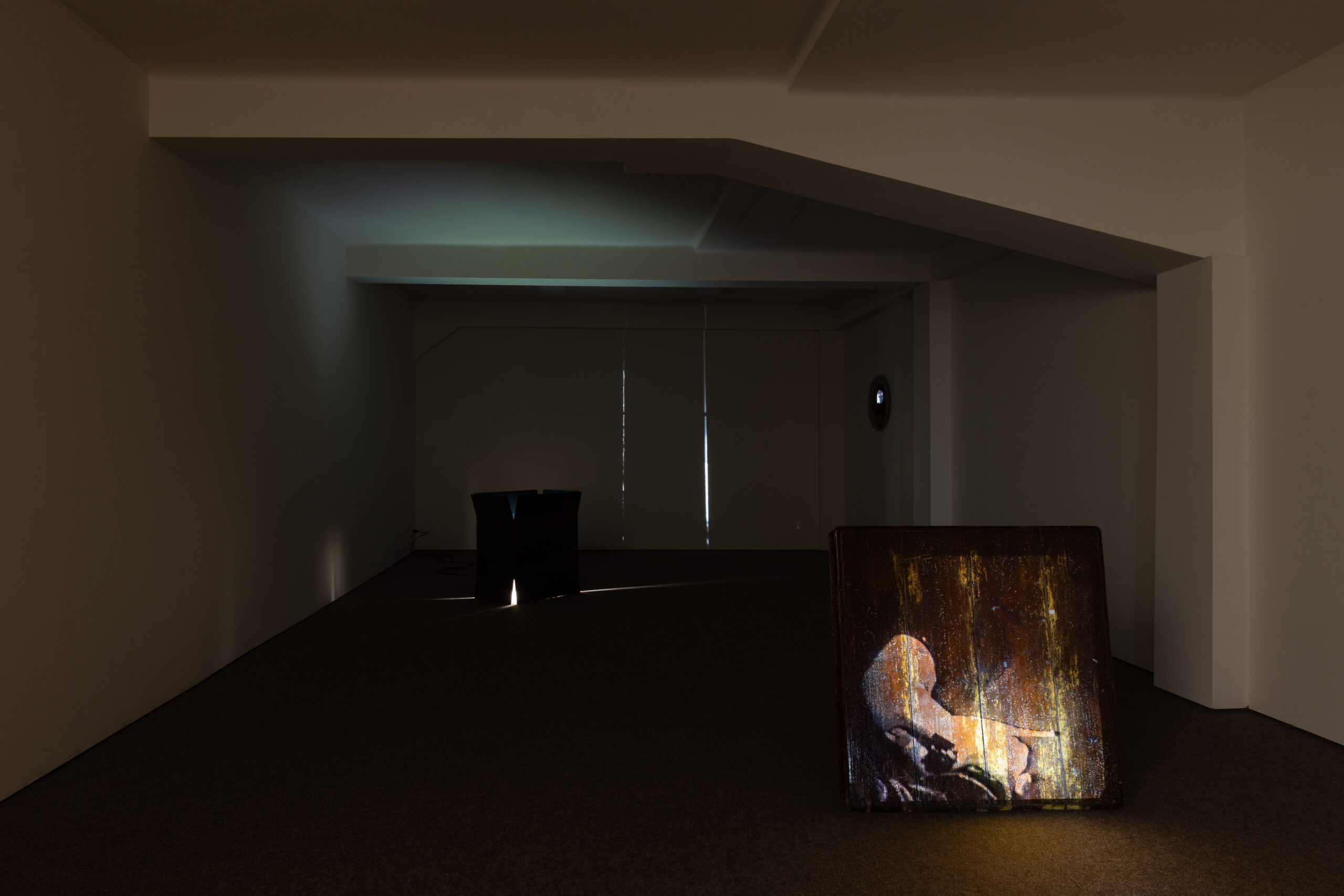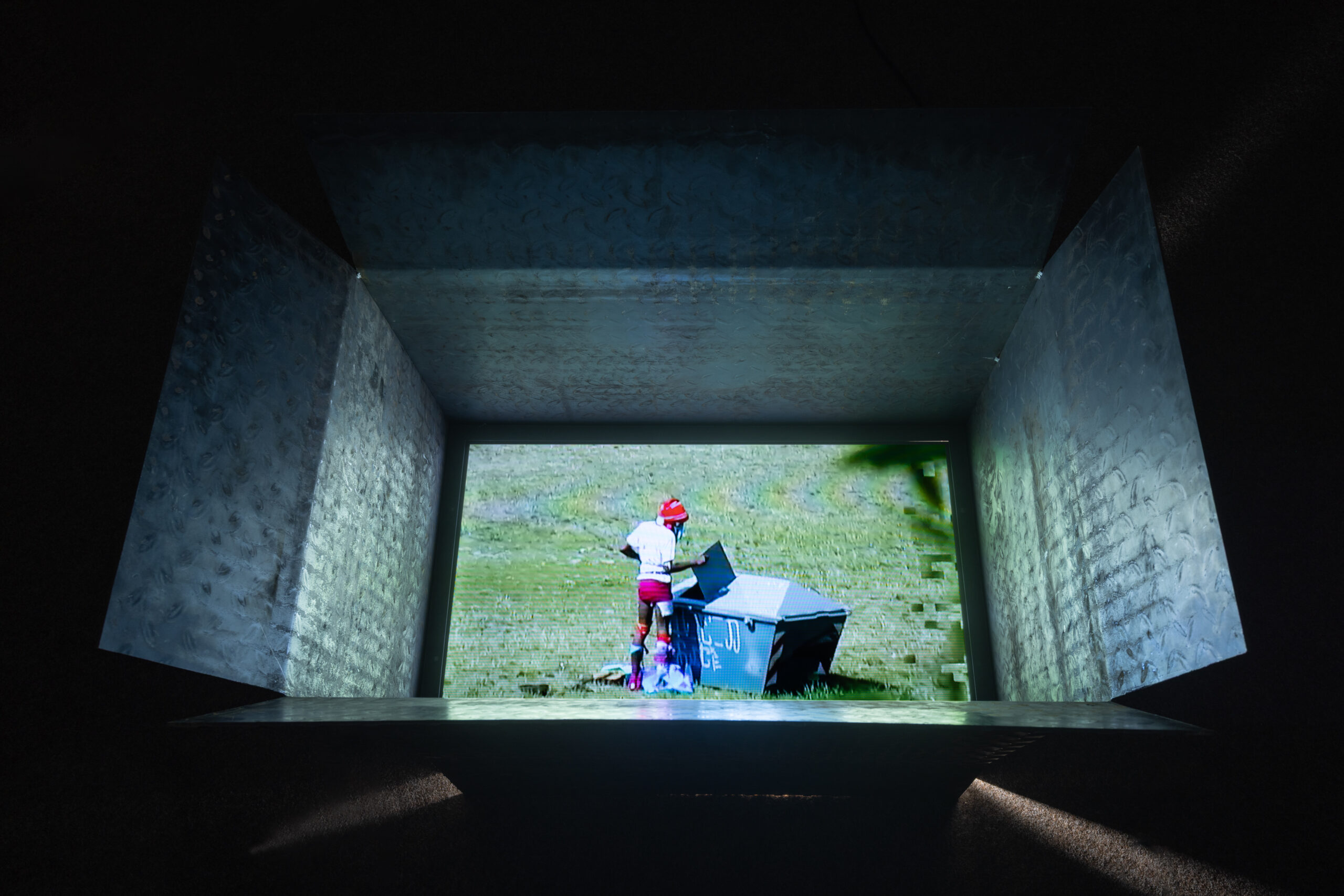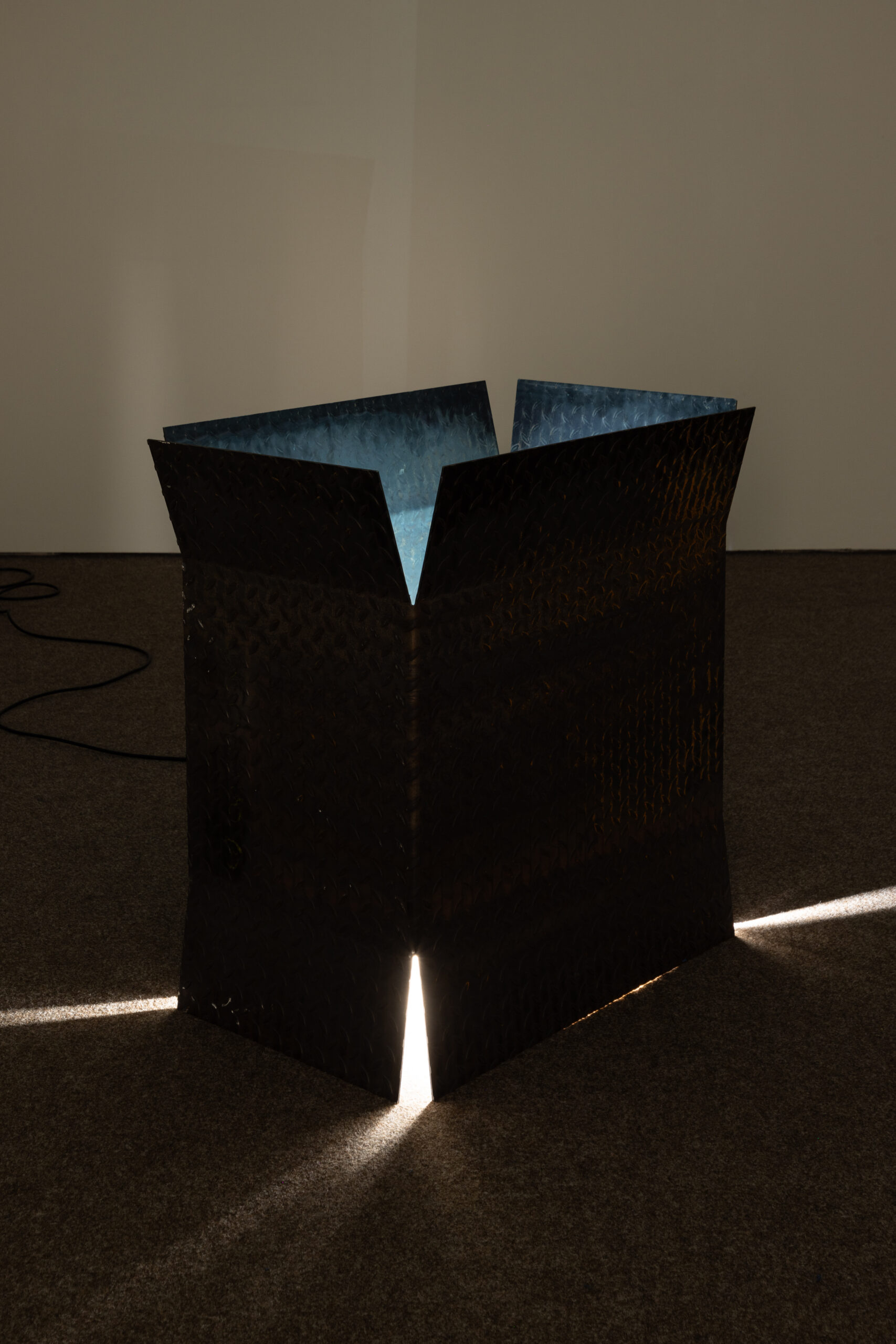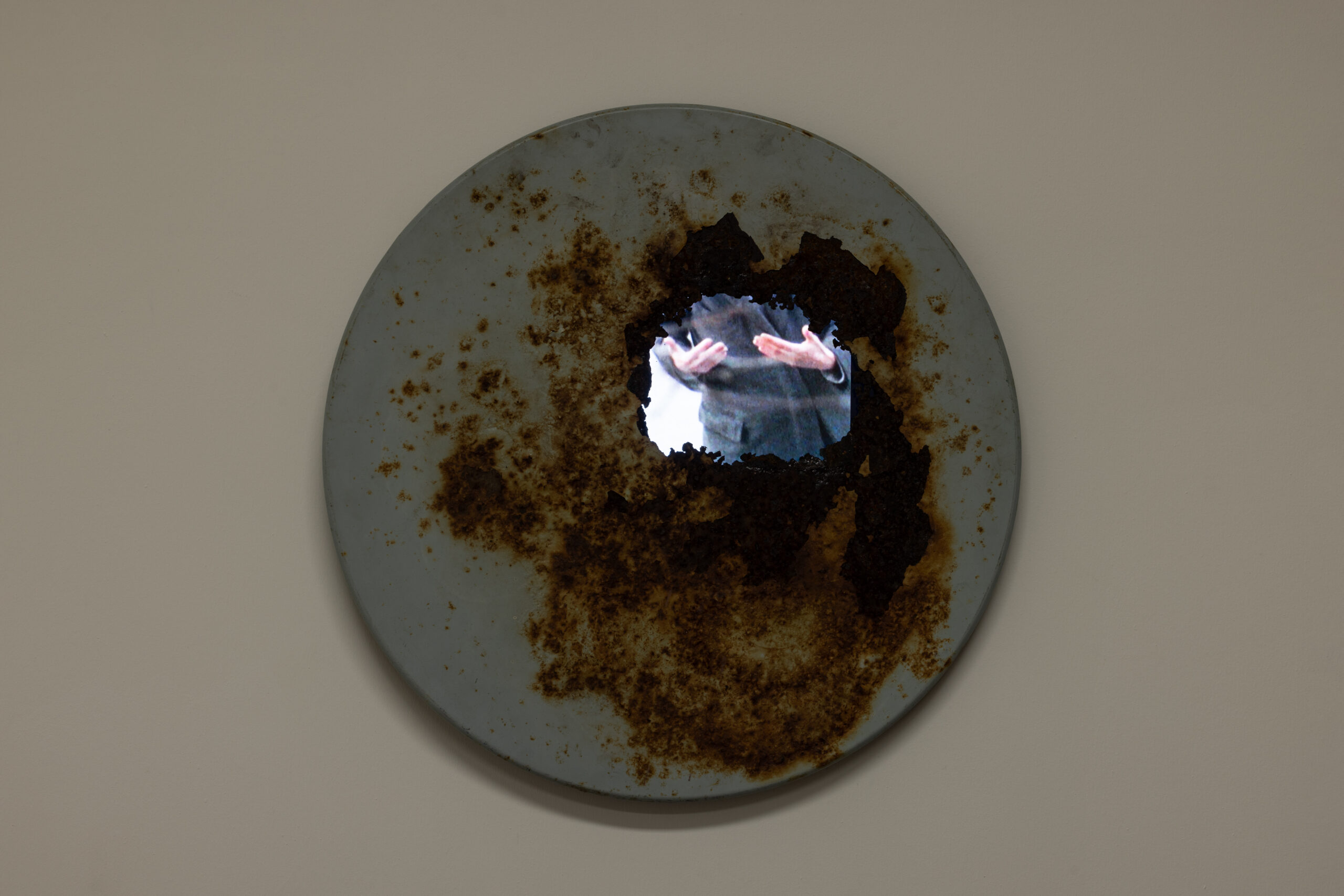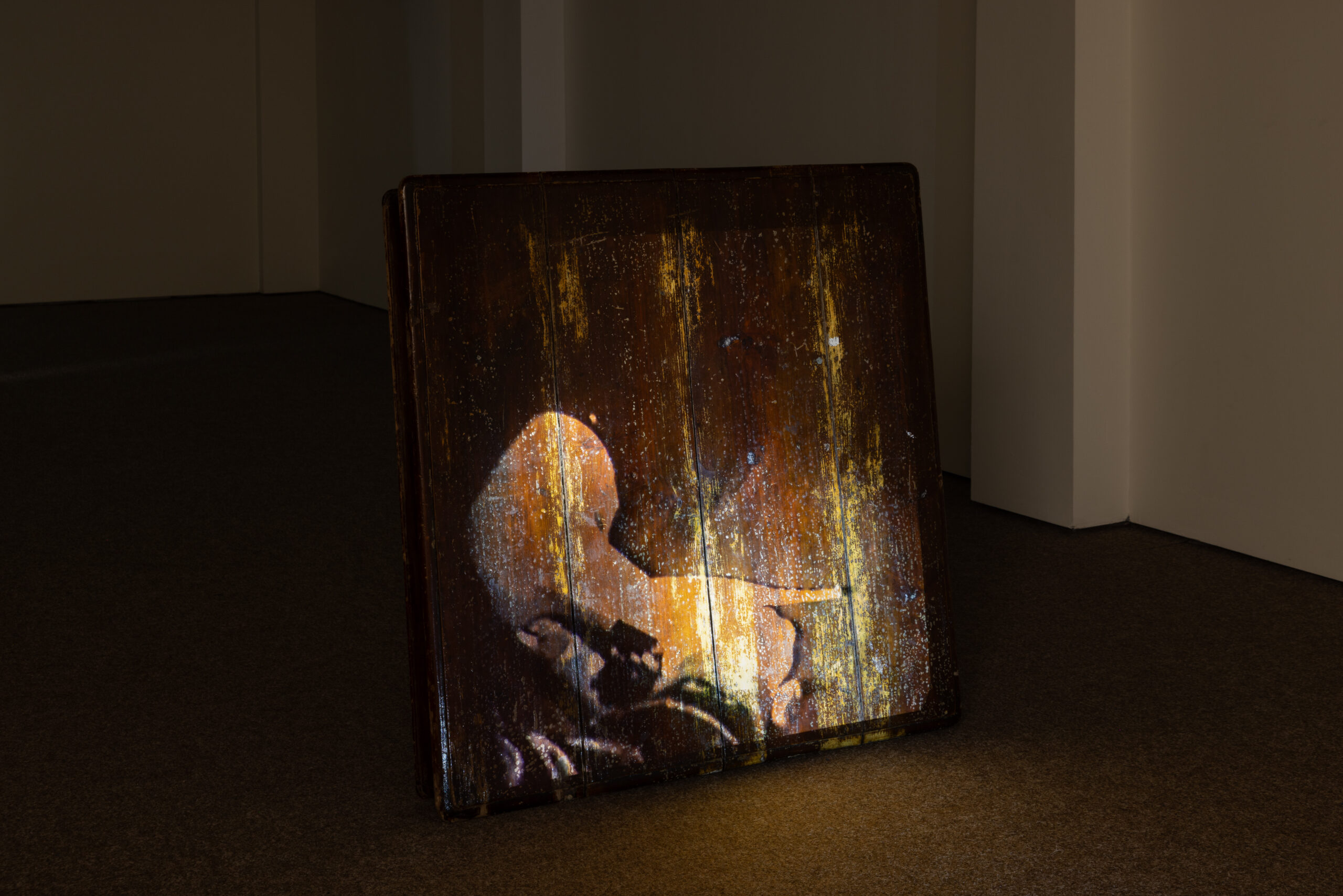Gume (EDGE) - Buraco. 2025
Gume (Edge) (ENG)
The restless nature of the work of Rui Calçada Bastos (Lisbon, 1971) presupposes a constant alternation of its associated practices, be they painting (a major case in recent years), installation, photography, performance or video. Gume [Edge] brings together the artist’s first three video works since Spectateur Éternel (2016), which marked the beginning of a decade characterised by the absence of the moving image and, more recently, by a return to painting and the sculptural object. Confronted with the revisitation of an archive of footage from the late 1990s to the early 2000s, Calçada Bastos once again reflects on the capture of human gestures that give the urban landscape a constant, irreparable, strangely elegiac sense of chaos and entropy, albeit in a link with his pictorial practice. Starting the exhibition with Video Still Painting (2025), the artist recalls the transversal influence this piece continues to have on his work, presenting a painting with an image from Same old tune (2005), a work in which he films himself walking on a spinning plate to the sound of Marlene Dietrich—another spring, another love and yet its always the same. Although there is a subliminal poetic tendency to all of Calçada Bastos’ work, Gume explores in a strangely more violent way the questioning of situations where small signs of obsession or madness seem to occur. The artist captures fleeting and borderline sequences that were once invisible in the fabric of the city, signs whose impenetrability, caused by contempt or repetition, often hide an enigmatic nature (sometimes indecipherable and obscure).
In 2006, the artist filmed a man wandering in front of a metallised container in Görlitzer Park in Berlin. The image begins with the serenity of an encounter which, at first glance, shows a person’s curiosity about the strange object sitting on the green grass of the garden. What appears to be an example of the banality of everyday life becomes the stuff of mania as the man’s (previously calm) body language changes and instigates a kind of compulsive action towards the opening of the container door, as if it were a suddenly closed access. The gesture is repeated dozens of times, increasing in intensity and speed. Accompanied by a growing peripheral awareness, it’s as if an aura of vigilance and distrust has formed around this interaction, with the film ending with a prolonged glance at the camera before the loop restarts. Like the other works in the exhibition, the artist builds a sculptural object referring to the container in the video, also made of standardised industrial iron. A frequent overlap in previous works (i.e. Soundscape or attempt to reproduce the sound of the day before from 2007), the sculptural quality of the work is accompanied by its function as a device for the apprehension of the video, not only in terms of its visualisation (on a screen inside the object), but also its sonic propensity in space which, by reverberating with the iron, gives the sound a metallic and echoing intonation. It is also by approaching the work that the artist achieves a concordance with the filmed scene and the performativity necessary to visualise it, replicating in the viewer the same movement suggested by the footage and introducing what becomes the hidden contemplative tone of the exhibition.
The same happens in Hands (Paris), a video installation that inserts the sequence of a frantic and incessant gesticulating language under the rusty hole of a coffee table. The decay of the object gives the work a languid and, once again, repetitive temporal quality, demonstrating the certainty that this could be one of the many behavioural phenomena eternally vulgarised in a noisy and disconnected urban context. Positioned at a height that contrasts with the other crawling and heavy presences in the exhibition, these hands seem trapped in their attempt to get closer and closer to their surroundings, as if they were the appendages of a failed preacher or Demiurge.
Operating almost as a backdrop to the context suggested by the group of works, the video projection Vespa (Macau) focuses on a wooden surface with a temporal patina very similar to that seen in Görlitzer Park (Berlin) or Hands (Paris). This time on a wooden table with varnished slats, the sequence of a motorbike journey is filmed from the perspective of the artist, who collects images of a troubled road that is imperceptible due to the darkness. Diluting between the narrow slats of the projectionscreen, the remnants of the video that cross this surface form slow, inconstant lines of movement on the wall in the background, subtly alluding to the guides of a road that stubbornly cannot be seen.
Gume synthesises a set of raw and flagrant images. Rendered through a complex method of juxtaposition with objects that are part of a very particular poetic imaginary, these images reverberate the plastic and formal power of the artist’s work in terms of the multiplicity of his lexicon (particularly with regard to his approach to scale, medium and what is often called tone). Vacillating, with a sharp and simple tension, in the face of the phenomena of capture and attention, the exhibition brings together part of a vast body of work about situations on the edge—a constant suggested by the recurrence on matters of the ineffable and the surreal.
Eva Mendes 2025
____________________________________________________________________________________________________________________________________________________________________
Gume (PT)
A natureza inquieta do trabalho de Rui Calçada Bastos (Lisboa, 1971) pressupõe senão uma constante alternância das práticas a si associadas, sejam estas a pintura (caso maior nos últimos anos), a instalação, a fotografia, a performance ou o vídeo. Em Gume, congregam-se as primeiras três obras em vídeo do artista desde Spectateur Éternel (2016), trabalho que assinalou o início de uma década marcada pela ausência da imagem em movimento e, mais recentemente, pelo retorno à pintura e ao objeto escultórico. É face ao reencontro de um arquivo de filmagens datadas entre o fim dos anos 90 e o início dos anos 2000 que Calçada Bastos torna a refletir sobre a captura de gestos humanos que denotam à paisagem urbana uma constante e irreparável sensação de caos, entropia e estranha elegia, mas não sem consentir o seu vínculo à prática pictórica. Iniciando a exposição com Video Still Painting (2025), o artista recorda a influência transversal que o vídeo continua a ter no seu trabalho, apresentando uma pintura com uma imagem oriunda de Same old tune (2005), obra em que se filma a caminhar sobre uma placa giratória ao som de Marlene Dietrich—another spring, another love and yet its always the same. Apesar de existir uma tendência poética subliminar a toda a obra de Calçada Bastos, Gume explora de uma forma estranhamente mais violenta o questionamento perante situações onde pequenos sinais de obsessão ou loucura parecem acontecer. São capturadas pelo artista sequências fugazes e de limite outrora invisíveis na trama citadina, sinais cuja impenetrabilidade causada pelo desprezo ou repetição escondem, não raramente, uma natureza enigmática (por vezes indecifrável e obscura).
Em 2006, o artista filma um homem a deambular frente a um contentor metalizado em Görlitzer Park, em Berlim. A imagem começa com a serenidade de um encontro que, a um primeiro olhar, demonstra a curiosidade de uma pessoa perante o estranho objeto sediado sobre a relva verde do jardim. O que parece ser um exemplo da banalidade dos dias, transforma-se em matéria de mania à medida que a linguagem corporal do homem (anteriormente tranquilo) se transforma e instiga uma espécie de ação compulsiva perante a abertura da porta do contentor, como
se de um acesso subitamente encerrado se tratasse. O gesto é repetido dezenas de vezes, aumentando a sua intensidade e velocidade. Acompanhado por uma crescente consciência periférica, é como se uma aura de vigília e desconfiança se formasse em torno desta interação, terminando a filmagem com um prolongado olhar para a câmara antes de se reiniciar o loop.
À semelhança das restantes obras da exposição, o artista constrói um objeto escultórico referente ao contentor presente no vídeo, também este em ferro industrial padronizado. Sobreposição frequente em trabalhos anteriores (i.e. Soundscape or attempt to reproduce the sound of the day before de 2007), a qualidade escultórica da obra é acompanhada pela sua função enquanto dispositivo para a apreensão do vídeo, não só no que respeita a sua visualização (realizada através de um ecrã inserido no interior do objeto), como a sua propensão sonora no espaço que, ao reverberar com o ferro, concede ao som uma entoação metálica e em eco. É também através da aproximação à obra que é conseguida pelo artista uma concordância relativamente à cena filmada e a performatividade necessária para a visualização da obra, replicando no espetador o mesmo movimento sugerido pela imagem e introduzindo aquele que se torna o dissimulado tom contemplativo da exposição.
O mesmo se sucede em Hands (Paris), uma instalação vídeo que insere a sequência de uma linguagem gesticular frenética e incessante sob o buraco ferrugento de uma mesa de café. A decadência do objeto concede à obra uma qualidade temporal lânguida e, uma vez mais, repetitiva, demonstrando a certeza de que este poderá ser um dos muitos fenómenos comportamentais eternamente vulgarizados num ruidoso e desvinculado contexto urbano. Posicionadas a uma altura que contraste com as restantes presenças rastejantes e pesadas da exposição, estas mãos parecem aprisionadas na sua tentativa de aproximação e estreiteza perante o ambiente envolvente, como se membros de um pregador ou Demiurgo falhado se tratassem. Operando quase como fundo para o contexto sugerido pelo conjunto de obras, a projeção vídeo Vespa (Macau) incide sobre uma superfície de madeira com uma patina temporal muito semelhante à verificada em Görlitzer Park (Berlin) ou Hands (Paris). Desta vez inserida numa mesa de madeira de ripas envernizadas, a sequência de uma viagem de mota é filmada através da perspetiva do artista que coleciona imagens de um caminho atribulado e imperceptível pela escuridão. Diluindo-se por entre as estreitas frechas da tela de projeção, os resquícios do vídeo que atravessam esta superfície formam na parede ao fundo linhas de movimento vagarosas
e inconstantes, subtilmente aludindo às guias de uma estrada que teima em não se ver.
Gume sintoniza um conjunto de imagens cruas e flagrantes. Renderizadas através de um complexo método de justaposição com objetos que integram um imaginário poético muito particular, estas imagens reverberam a potência plástica e formal do trabalho do artista no que respeita a multiplicidade do seu léxico (nomeadamente referente à sua abordagem à escala,
ao meio e ao frequentemente denominado tom). Vacilando, com uma tensão aguçada e singela, perante os fenómenos da captura e da atenção, a exposição reune parte de um vasto conjunto de trabalhos acerca do lugar de limite e de frecha—um gume sugerido pela constante reincidência sobre matérias do inefável e do surreal.
Eva Mendes, 2025
